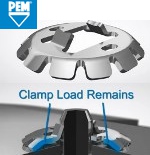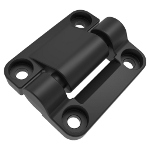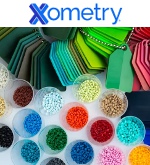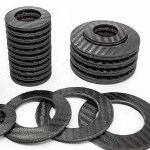 |
| December 26, 2023 | Volume 19 Issue 48 |
Mechanical News & Products
Designfax weekly eMagazine
Archives
Partners
Manufacturing Center
Product Spotlight
Modern Applications News
Metalworking Ideas For
Today's Job Shops
Tooling and Production
Strategies for large
metalworking plants
New 'breathable' rupture disk tech provides overpressure and vacuum relief
 To increase equipment safety and reliability, a new rupture disk technology activates at a set burst pressure, but it can also "breathe" to relieve minor pressure fluctuations. The patent-pending, dual-function device from BS&B Safety Systems is ideal for use on low-pressure vessels that are susceptible to ambient temperature changes.
To increase equipment safety and reliability, a new rupture disk technology activates at a set burst pressure, but it can also "breathe" to relieve minor pressure fluctuations. The patent-pending, dual-function device from BS&B Safety Systems is ideal for use on low-pressure vessels that are susceptible to ambient temperature changes.
Read the full article.
Engineer's Toolbox: 9 considerations for specifying a slewing ring bearing
 In applications that require a bearing to support a structure while it rotates (e.g., cranes, radar, tank turrets), premature bearing failure can put people and equipment at risk. While slewing ring bearings have proven themselves countless times in such applications, designers must consider many factors when specifying them. According to engineers at Kaydon, the bearing's support structure, mounting (including bolt strength, tensioning, and hole patterns), installation, and even storage are all factors in a bearing's success or failure.
In applications that require a bearing to support a structure while it rotates (e.g., cranes, radar, tank turrets), premature bearing failure can put people and equipment at risk. While slewing ring bearings have proven themselves countless times in such applications, designers must consider many factors when specifying them. According to engineers at Kaydon, the bearing's support structure, mounting (including bolt strength, tensioning, and hole patterns), installation, and even storage are all factors in a bearing's success or failure.
Read the full article.
ClampDisk micro fastener is new alternative for automotive and consumer electronics
 Designed as a unique alternative in assemblies for the automotive and consumer electronics markets, the ClampDisk Press-on Fastener is a new offering from PennEngineering that delivers a fast, simple way to achieve sheet-to-sheet clamped fastening while replacing the use of standard screws, nuts, and adhesives. The most common challenges that can be eliminated or reduced by using ClampDisk include over installation, cross threading, stripped screw heads, broken screws, and damaged product. This fastener can be removed easily with a sharp-edged tool.
Designed as a unique alternative in assemblies for the automotive and consumer electronics markets, the ClampDisk Press-on Fastener is a new offering from PennEngineering that delivers a fast, simple way to achieve sheet-to-sheet clamped fastening while replacing the use of standard screws, nuts, and adhesives. The most common challenges that can be eliminated or reduced by using ClampDisk include over installation, cross threading, stripped screw heads, broken screws, and damaged product. This fastener can be removed easily with a sharp-edged tool.
Learn more and see how ClampDisk works.
New nylon constant torque hinge
 Southco has expanded its line of E6 Constant Torque Hinges with a compact, nylon version designed for small applications. The newest addition to the company's E6 50 Constant Torque Position Control Hinge series measures 45 mm with a torque range of 4 to 16 in./lb and is 65% lighter compared to the standard E6 50 Hinge. It provides constant resistance throughout the entire range of motion, enabling users to easily position doors, display screens, and other mounted components and hold them securely at any desired angle.
Southco has expanded its line of E6 Constant Torque Hinges with a compact, nylon version designed for small applications. The newest addition to the company's E6 50 Constant Torque Position Control Hinge series measures 45 mm with a torque range of 4 to 16 in./lb and is 65% lighter compared to the standard E6 50 Hinge. It provides constant resistance throughout the entire range of motion, enabling users to easily position doors, display screens, and other mounted components and hold them securely at any desired angle.
Learn more.
What injection molding material do I use?
 How do you decide what type of plastic to use for your next injection molding project? Xometry can help you narrow your choices. Discover the different strengths and applications for materials that could be ideal for your application by learning about the most common plastic injection molding materials in detail.
How do you decide what type of plastic to use for your next injection molding project? Xometry can help you narrow your choices. Discover the different strengths and applications for materials that could be ideal for your application by learning about the most common plastic injection molding materials in detail.
Read this detailed Xometry article.
What are carbon composite bellows springs?
 The Carbon Composite Bellows Spring (CCBS) from MW Components is a system of carbon fiber elements that combine to work as a high-performance, lightweight, and design-flexible compression spring meant to replace coil springs or metallic Belleville disc springs. A functional spring is made from several individual elements paired and joined to make a stack. The stack spring rate is determined by the number of elements, the base rate of each element, and their series or parallel orientation in the stack. Applications include motorsports, aerospace, and high-performance activities.
The Carbon Composite Bellows Spring (CCBS) from MW Components is a system of carbon fiber elements that combine to work as a high-performance, lightweight, and design-flexible compression spring meant to replace coil springs or metallic Belleville disc springs. A functional spring is made from several individual elements paired and joined to make a stack. The stack spring rate is determined by the number of elements, the base rate of each element, and their series or parallel orientation in the stack. Applications include motorsports, aerospace, and high-performance activities.
Learn more.
Conductive Brush Ring overcomes current leakage in EV powertrains
 SKF's new Conductive Brush Ring paves the way to greater reliability and longer life in high-performance electric vehicle powertrain systems. Using pure carbon fiber bristles, it provides a reliable electrical connection between an EV eAxle rotor shaft and its housing. When used in combination with SKF Hybrid ceramic ball bearings, it helps to alleviate parasitic current effects that can lead to premature failure in bearings and other components. Available in different configurations for wet (oil-lubricated) motor designs -- and soon for dry (sealed) applications.
SKF's new Conductive Brush Ring paves the way to greater reliability and longer life in high-performance electric vehicle powertrain systems. Using pure carbon fiber bristles, it provides a reliable electrical connection between an EV eAxle rotor shaft and its housing. When used in combination with SKF Hybrid ceramic ball bearings, it helps to alleviate parasitic current effects that can lead to premature failure in bearings and other components. Available in different configurations for wet (oil-lubricated) motor designs -- and soon for dry (sealed) applications.
Learn more.
hyperMILL 2024 CAD/CAM software suite
 OPEN MIND Technologies has introduced its latest hyperMILL 2024 CAD/CAM software suite, which includes a range of powerful enhancements to its core toolpath capabilities, as well as new functionality for increased NC programming efficiency in applications ranging from 2.5D machining to 5-axis milling. New and enhanced capabilities include: Optimized Deep Hole Drilling, a new algorithm for 3- and 5-axis Rest Machining, an enhanced path layout for the 3D Plane Machining cycle, better error detection, and much more.
OPEN MIND Technologies has introduced its latest hyperMILL 2024 CAD/CAM software suite, which includes a range of powerful enhancements to its core toolpath capabilities, as well as new functionality for increased NC programming efficiency in applications ranging from 2.5D machining to 5-axis milling. New and enhanced capabilities include: Optimized Deep Hole Drilling, a new algorithm for 3- and 5-axis Rest Machining, an enhanced path layout for the 3D Plane Machining cycle, better error detection, and much more.
Learn more.
One-part epoxy changes from red to clear under UV
 Master Bond UV15RCL is a low-viscosity, cationic-type UV-curing system with a special color-changing feature. The red material changes to clear once exposed to UV light, indicating that there is UV light access across the adhesive material. Although this change in color from red to clear does not indicate a full cure, it does confirm that the UV light has reached the polymer. This epoxy is an excellent electrical insulator. UV15RCL adheres well to metals, glass, ceramics, and many plastics, including acrylics and polycarbonates.
Master Bond UV15RCL is a low-viscosity, cationic-type UV-curing system with a special color-changing feature. The red material changes to clear once exposed to UV light, indicating that there is UV light access across the adhesive material. Although this change in color from red to clear does not indicate a full cure, it does confirm that the UV light has reached the polymer. This epoxy is an excellent electrical insulator. UV15RCL adheres well to metals, glass, ceramics, and many plastics, including acrylics and polycarbonates.
Learn more.
SPIROL Press-N-Lok™ Pin for plastic housings
 The Press-N-Lok™ Pin was designed to permanently retain two plastic components to each other. As the pin is inserted, the plastic backfills into the area around the two opposing barbs, resulting in maximum retention. Assembly time is quicker, and it requires lower assembly equipment costs compared to screws and adhesives -- just Press-N-Lok™!
The Press-N-Lok™ Pin was designed to permanently retain two plastic components to each other. As the pin is inserted, the plastic backfills into the area around the two opposing barbs, resulting in maximum retention. Assembly time is quicker, and it requires lower assembly equipment costs compared to screws and adhesives -- just Press-N-Lok™!
Learn more about the new Press-N-Lok™ Pin.
Why hybrid bearings are becoming the new industry standard
 A combination of steel outer and inner rings with ceramic balls or rollers is giving hybrid bearings unique properties, making them suitable for use in a wide range of modern applications. SKF hybrid bearings make use of silicon nitride (twice as hard as bearing steel) rolling elements and are available as ball bearings, cylindrical roller bearings, and in custom designs. From electric erosion prevention to friction reduction and extended maintenance intervals, learn all about next-gen hybrid bearings.
A combination of steel outer and inner rings with ceramic balls or rollers is giving hybrid bearings unique properties, making them suitable for use in a wide range of modern applications. SKF hybrid bearings make use of silicon nitride (twice as hard as bearing steel) rolling elements and are available as ball bearings, cylindrical roller bearings, and in custom designs. From electric erosion prevention to friction reduction and extended maintenance intervals, learn all about next-gen hybrid bearings.
Read the SKF technical article.
3M and Ansys train engineers on simulating adhesives
 Ansys and 3M have created an advanced simulation training program enabling engineers to enhance the design and sustainability of their products when using tapes and adhesives as part of the design. Simulation enables engineers to validate engineering decisions when analyzing advanced polymeric materials -- especially when bonding components made of different materials. Understand the behavior of adhesives under real-world conditions for accurate modeling and design.
Ansys and 3M have created an advanced simulation training program enabling engineers to enhance the design and sustainability of their products when using tapes and adhesives as part of the design. Simulation enables engineers to validate engineering decisions when analyzing advanced polymeric materials -- especially when bonding components made of different materials. Understand the behavior of adhesives under real-world conditions for accurate modeling and design.
Read this informative Ansys blog.
New FATH T-slotted rail components in black from AutomationDirect
 Automation-Direct has added a wide assortment of black-colored FATH T-slotted hardware components to match their SureFrame black anodized T-slotted rails, including: cube connectors (2D and 3D) and angle connectors, joining plates of many types, brackets, and pivot joints. Also included are foot consoles, linear bearings in silver and black, cam lever brakes, and L-handle brakes. FATH T-slotted hardware components are easy to install, allow for numerous T-slotted structure configurations, and have a 1-year warranty against defects.
Automation-Direct has added a wide assortment of black-colored FATH T-slotted hardware components to match their SureFrame black anodized T-slotted rails, including: cube connectors (2D and 3D) and angle connectors, joining plates of many types, brackets, and pivot joints. Also included are foot consoles, linear bearings in silver and black, cam lever brakes, and L-handle brakes. FATH T-slotted hardware components are easy to install, allow for numerous T-slotted structure configurations, and have a 1-year warranty against defects.
Learn more.
Weird stuff: Moon dust simulant for 3D printing
 Crafted from a lunar regolith simulant, Basalt Moon Dust Filamet™ (not a typo) available from The Virtual Foundry closely mirrors the makeup of lunar regolith found in mare regions of the Moon. It enables users with standard fused filament fabrication (FFF) 3D printers to print with unparalleled realism. Try out your ideas before you go for that big space contract, or help your kid get an A on that special science project.
Crafted from a lunar regolith simulant, Basalt Moon Dust Filamet™ (not a typo) available from The Virtual Foundry closely mirrors the makeup of lunar regolith found in mare regions of the Moon. It enables users with standard fused filament fabrication (FFF) 3D printers to print with unparalleled realism. Try out your ideas before you go for that big space contract, or help your kid get an A on that special science project.
Learn more.
Break the mold with custom injection molding by Rogan
 With 90 years of industry experience, Rogan Corporation possesses the expertise to deliver custom injection molding solutions that set businesses apart. As a low-cost, high-volume solution, injection molding is the most widely used plastics manufacturing process. Rogan processes include single-shot, two-shot, overmolding, and assembly. Elevate your parts with secondary operations: drilling and tapping, hot stamping, special finishes, punch press, gluing, painting, and more.
With 90 years of industry experience, Rogan Corporation possesses the expertise to deliver custom injection molding solutions that set businesses apart. As a low-cost, high-volume solution, injection molding is the most widely used plastics manufacturing process. Rogan processes include single-shot, two-shot, overmolding, and assembly. Elevate your parts with secondary operations: drilling and tapping, hot stamping, special finishes, punch press, gluing, painting, and more.
Learn more.
Engineers develop a way to determine how the surfaces of materials behave
Using machine learning, the computational method can provide details of how materials work as catalysts, semiconductors, or battery components.
By David L. Chandler, MIT
Designing new compounds or alloys whose surfaces can be used as catalysts in chemical reactions can be a complex process relying heavily on the intuition of experienced chemists. A team of researchers at MIT has devised a new approach using machine learning that removes the need for intuition and provides more detailed information than conventional methods can practically achieve.
For example, applying the new system to a material that has already been studied for 30 years by conventional means, the team found the compound's surface could form two new atomic configurations that had not previously been identified, and that one other configuration seen in previous works is likely unstable.

MIT researchers devised a machine-learning-based method to investigate how materials behave at their surfaces. The approach could help in developing compounds or alloys for use as catalysts, semiconductors, or battery components. [Credit: MIT News]
The findings are described in the journal Nature Computational Science in a paper by MIT graduate student Xiaochen Du, professors Rafael Gomez-Bombarelli and Bilge Yildiz, MIT Lincoln Laboratory technical staff member Lin Li, and three others.
Surfaces of materials often interact with their surroundings in ways that depend on the exact configuration of atoms at the surface, which can differ depending on which parts of the material's atomic structure are exposed. Think of a layer cake with raisins and nuts in it: Depending on exactly how you cut the cake, different amounts and arrangements of the layers and fruits will be exposed on the edge of your slice. The environment matters as well. The cake's surface will look different if it is soaked in syrup, making it moist and sticky, or if it is put in the oven, crisping and darkening the surface. This is akin to how materials' surfaces respond when immersed in a liquid or exposed to varying temperatures.
Methods usually used to characterize material surfaces are static, looking at a particular configuration out of the millions of possibilities. The new method allows an estimate of all the variations, based on just a few first-principles calculations automatically chosen by an iterative machine-learning process, in order to find those materials with the desired properties.
In addition, unlike typical present methods, the new system can be extended to provide dynamic information about how the surface properties change over time under operating conditions, for example while a catalyst is actively promoting a chemical reaction, or while a battery electrode is charging or discharging.
The researchers' method, which they call an Automatic Surface Reconstruction framework, avoids the need to use hand-picked examples of surfaces to train the neural network used in the simulation. Instead, it starts with a single example of a pristine cut surface, then uses active learning combined with a type of Monte-Carlo algorithm to select sites to sample on that surface, evaluating the results of each example site to guide the selection of the next sites. Using fewer than 5,000 first-principles calculations, out of the millions of possible chemical compositions and configurations, the system can obtain accurate predictions of the surface energies across various chemical or electrical potentials, the team reports.
"We are looking at thermodynamics," Du says, "which means that, under different kinds of external conditions such as pressure, temperature, and chemical potential, which can be related to the concentration of a certain element, [we can investigate] what is the most stable structure for the surface?"
In principle, determining the thermodynamic properties of a material's surface requires knowing the surface energies across a specific single atomic arrangement and then determining those energies millions of times to encompass all the possible variations and to capture the dynamics of the processes taking place. While it is possible in theory to do this computationally, "It's just not affordable" at a typical laboratory scale, Gomez-Bombarelli says. Researchers have been able to get good results by examining just a few specific cases, but this isn't enough cases to provide a true statistical picture of the dynamic properties involved, he says.
Using their method, Du says, "We have new features that allow us to sample the thermodynamics of different compositions and configurations. We also show that we are able to achieve these at a lower cost, with fewer expensive quantum mechanical energy evaluations -- and we are also able to do this for harder materials," including three-component materials.
"What is traditionally done in the field," he says, "is researchers, based on their intuition and knowledge, will test only a few guess surfaces. But we do comprehensive sampling, and it's done automatically."
Du adds, "We've transformed a process that was once impossible or extremely challenging due to the need for human intuition. Now, we require minimal human input. We simply provide the pristine surface, and our tool handles the rest."
That tool, or set of computer algorithms, called AutoSurfRecon, has been made freely available by the researchers so it can be downloaded and used by any researchers in the world to help, for example, in developing new materials for catalysts, such as for the production of "green" hydrogen as an alternative emissions-free fuel, or for new battery or fuel cell components.
For example, Gomez-Bombarelli says, in developing catalysts for hydrogen production, "Part of the problem is that it's not really understood how their surface is different from their bulk as the catalytic cycle occurs. So, there's this disconnect between what the material looks like when it's being used and what it looks like when it's being prepared before it gets put into action."
He adds, "At the end of the day, in catalysis, the entity responsible for the catalyst doing something is a few atoms exposed on the surface, so it really matters a lot what exactly the surface looks like at the moment."
Another potential application is in studying the dynamics of chemical reactions used to remove carbon dioxide from the air or from power plant emissions. These reactions often work by using a material that acts as a kind of sponge for absorbing oxygen, so it strips oxygen atoms from the carbon dioxide molecules, leaving behind carbon monoxide, which can be a useful fuel or chemical feedstock. Developing such materials "requires understanding of what the surface does with the oxygens, and how it's structured," Gomez-Bombarelli says.
Using their tool, the researchers studied the surface atomic arrangement of the perovskite material strontium titanium oxide, or SrTiO3, which had already been analyzed by others using conventional methods for more than three decades yet was still not fully understood. They discovered two new arrangements of the atoms at its surface that had not been previously reported, and they predict that one arrangement that had been reported is in fact unlikely to occur at all.
"This highlights that the method works without intuitions," Gomez-Bombarelli says, "and that's good, because sometimes intuition is wrong, and what people have thought was the case turns out not to be." This new tool, he says, will allow researchers to be more exploratory, trying out a broader range of possibilities.
Now that their code has been released to the community at large, he says, "We hope that it will be inspiration for very quick improvements" by other users.
Published December 2023
Rate this article
View our terms of use and privacy policy

